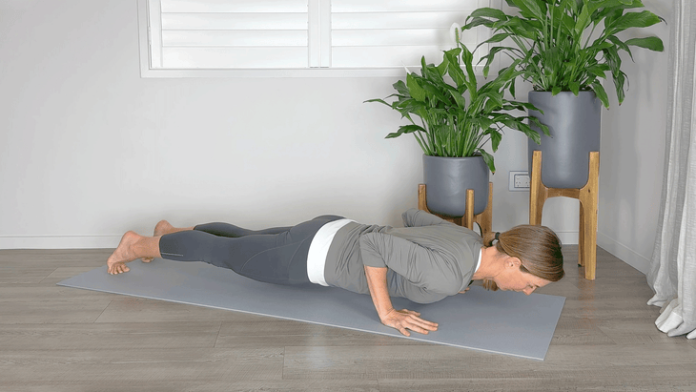“], “filter”: { “nextExceptions”: “img, blockquote, div”, “nextContainsExceptions”: “img, blockquote, a.btn, a.o-button”} }”>
Heading out the door? Read this article on the new Outside+ app available now on iOS devices for members!
>”,”name”:”in-content-cta”,”type”:”link”}}”>Download the app.
Ever contemplate why Chaturanga (aka Low Push-Up) feels soooo difficult despite it being ubiquitous in vinyasa yoga classes?
For starters, holding your full weight in place with just your hands and tiptoes is hard enough in Plank Pose. But when you bend your elbows, you take away the precious stability you gained by bracing your arms straight. Additionally, Chaturanga Dandasana (Four Limb Staff Pose) is typically practiced as though it’s little more than a pit stop between Plank and Upward-Facing Dog (Urdhva Mukha Svanasana). That means you tend to pass through it by default, much like how you brush your teeth or get into your car. And it’s done so quickly that there’s practically zero time for the teacher to offer detailed instruction.
No wonder you may find yourself falling into compensatory habits that are tough to correct on the fly.
Unlearning your default alignment and programming it differently can require that you move through Chaturanga more slowly. It can also mean lowering your knees to the mat so you can decrease the amount of body weight you’re supporting and start paying attention to what’s actually happening in your body. Enlisting the external feedback of other props can also help you changed your patterned behavior.
Although these approaches require you to do things slightly differently than what others are doing in class, that’s actually part of the beauty as maybe someone else will learn a thing or two from you.
4 Most Common Misalignments in Chaturanga
Following are the most common misalignments teachers observe in Chaturanga along with what you can do to unlearn them.
1. Rounded Shoulders
This is the most common misalignment in Chaturanga thanks to two factors. First, the starting position of Chaturanga is Plank, where it’s not only natural but necessary for your shoulders to round toward your chest. If you bend your elbows from Plank without making any adjustment to shoulder position, that forward rounded position of your shoulders will be accentuated by the second factor, the downward pull of gravity.
Correct It With Cues: “Broaden Your Collarbones”
Once your elbows bend in Plank and start to lower yourself, it may be too late to make major changes to your alignment. But there are essential cues that can help when you start the process of not rounding well before you move out of Plank. Consider the cue “broaden your collarbones,” or in other words, lifting your chest or reaching your sternum forward toward the front of the mat. This action encourages the muscles of your posterior shoulder and upper back to contract and draw your shoulder blades back and down to balance the forward pull of gravity.
Keep that muscular engagement as you shift forward and bend your elbows in Chaturanga and your resulting shoulder position will be exactly what it should be, which is partway between the rounded shoulders of Plank and the broad chest of Upward Dog. Bonus: This alignment eases the transition between those two poses.
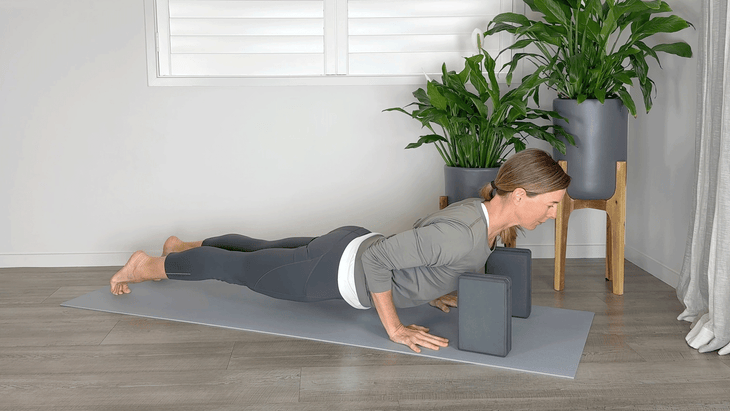
Correct it With Props: Blocks Beneath Your Shoulders
Set up in Plank Pose with one block on its highest orientation an inch or so in front of the middle finger of each hand. As you roll forward onto the tips of your toes and bend your elbows, the fronts of your shoulders will move toward the blocks. Instead of bringing your shoulders to rest on the blocks, lower your chest between them without letting your shoulders touch the blocks. Keep your core and legs strong. Pause for a moment to mark the buoyancy in your shoulders. Then recreate that feeling next time you practice Chaturanga without the blocks in place to remind you.
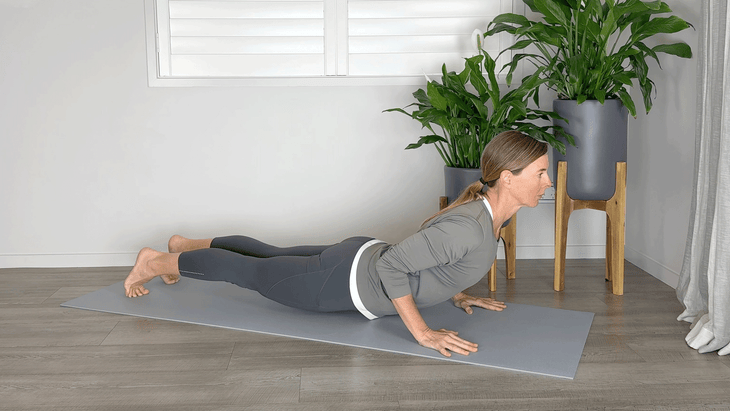
2. Sagging Low Back
In Plank and Chaturanga, the significant weight of your low back and pelvis are found roughly midway between your hands and feet. Even a momentary lack of focus on core and leg engagement can allow that weight to droop toward the mat. As you’re struggling to find and maintain a central shoulder position in Chaturanga, it becomes even more difficult not to neglect the alignment in the rest of your body, especially since it’s behind you and literally out of sight.
Correct It With Cues: “Navel to Spine” or “Draw Your Hands Toward Your Feet”
The counterpoint to a drooping low back is to increase core engagement. But it’s an uphill battle to change your alignment when you’re already sagging in Chaturanga. So start in Plank by hugging your belly button toward your spine or dragging your hands and feet toward each other without moving them, as if you’re trying to cause a wrinkle in the center of the mat. The front of your body, especially your abdominals and hip flexors, will contract to help support the weight of your low back and pelvis. Maintain that engagement as you shift forward and bend your elbows for Chaturanga.

Correct It With Props: Bolster or Stacked Folded Blankets Beneath You
Set up in Plank with a bolster or some stacked folded blankets lengthways on the mat beneath your low ribs, belly, and pelvis. If you were to lower to Chaturanga with your low back drooping, your pelvis and belly would touch the props before your low ribs. Instead, as you roll forward onto the tips of your toes and bend your elbows for Chaturanga, maintain a strong straight line from head to heels so that everything touches down at the same time. Memorize how it feels to maintain the needed core and leg engagement so you can repeat it without the bolster beneath you for feedback.

3. Elbows Squeezed In
A common cue that teachers like to say in Chaturanga is “hug your elbows in” or “draw your elbows toward your side ribs.” Both cues aim to align your elbows straight back from your shoulders, differentiating the narrow arms of Chaturanga from a wide-arm push-up position in which the elbows splay outward.
But even a useful cue can be taken too far. A common misalignment in Chaturanga, especially when your upper body strength is less than the pose demands, is to hug your elbows so close to your side body that you effectively rest your rib cage on your upper arms, almost like a shelf, to support your weight.
Correct It With Cues: “Elbows Toward Side Ribs Without Touching”
If you’re accustomed to dropping your rib cage onto your upper arms in Chaturanga, it will take a lot more than a few extra words to change your alignment. You’ll need to decrease the body weight you’re holding to help your upper body muscles pick up the slack. So from Plank Pose, shift forward to your tiptoes then lower your knees to the mat. As you bend your elbows, draw them toward your sides without letting your upper arms and side ribs touch. Pause in your knee-down Chaturanga to feel the strength your new alignment requires in your arms; you may need to continue to lower your knees in Chaturanga until your upper body strength increases.
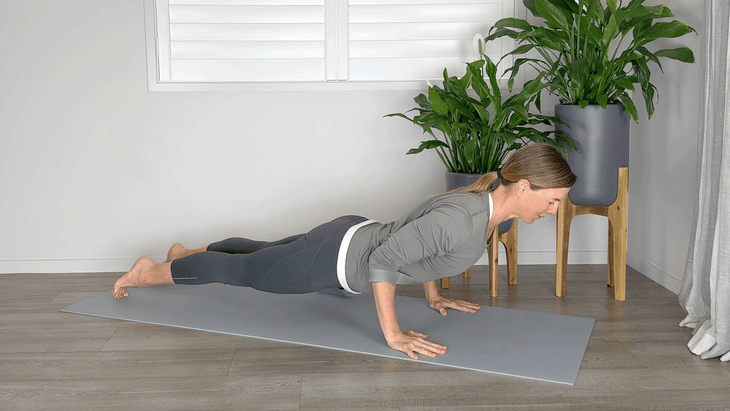
Correct It With Props: Strap Around Your Arms
Create a shoulder-width loop in a strap and slide it around your lower arms just below your elbows and then come into Plank. Shift forward onto your tiptoes and bend your elbows, moving toward Chaturanga. Notice that you could drop your chest down onto the strap and let its tension hold you, but that would only reinforce the dysfunctional pattern of dropping the weight of your torso onto your upper arms. Instead, as your low ribs touch the strap, press your arms outward and away from your sides to make the contact between your ribs and the strap light. Hold there for a moment to register how it feels to engage the strength of your arm muscles instead of using your arm bones as a shelf to rest on. Aim to recreate this feeling without the external support of the strap next time you practice Chaturanga.
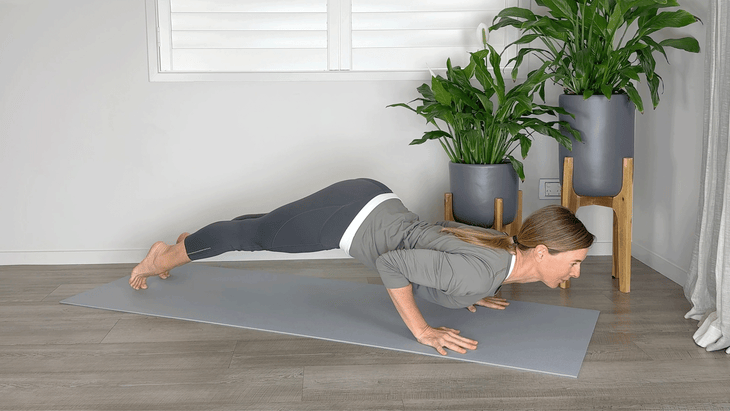
4. Hips High, Chest Low
In the early days of vinyasa yoga, it was common to “dive through” or “swim through” Chaturanga with the sit bones tilted high and the chest dipped low. This common misalignment could have developed as a heightened version of rounded shoulders, an overcorrection of low back sag, or in service of a more dramatic transition to Upward Dog. Its legacy lingers with this common misalignment. Sometimes this misalignment is sanctioned in the form of a commonly offered alternative to Chaturanga, which is coming to knees, chest, and chin in place of Chaturanga. This modification, unfortunately, trains the rounded shoulder position we are trying to avoid in Chaturanga.
Correct It With Cues: “Reach Your Sit Bones Back and Sternum Forward”
Countering this misalignment is complex, since it means adjusting both pelvic and shoulder positions at once. To give your body space to learn new patterns, it will help to set your alignment in Plank and decrease the body weight you are managing by lowering your knees to the mat.
As you prepare to move to chaturanga, create the neutral spine and pelvic positions you practice in Mountain Pose (Tadasana) by lengthening your sit bones toward your heels and turning your sternum slightly forward toward the front of your mat. Roll forward onto the tips of your toes and lower your knees. Keep a straight, strong line from head to knees as you slowly bend your elbows for Chaturanga. Notice how different it feels to lower with neutral alignment, and without the added drama of momentum; aim to repeat that feeling when you next practice Chaturanga.
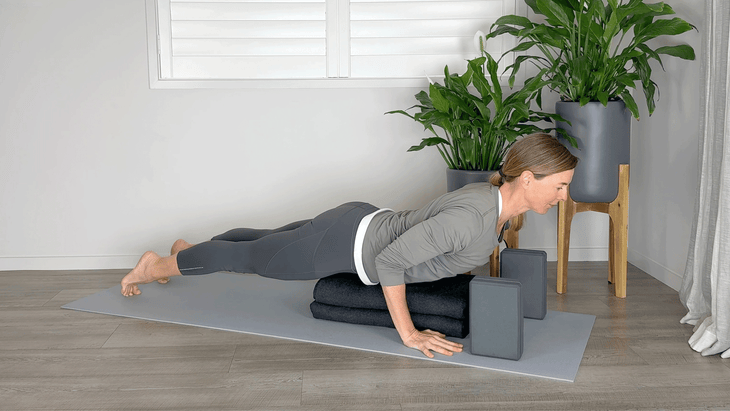
Correct It With Props: Props Under Shoulders and Torso
This misalignment pattern includes elements of other misalignments—your shoulders rounding forward and your lack of awareness about whether your belly, low ribs, and pubic bone are moving together or not (except this time your hips are misaligned by being lifted too high instead of sagging too low).
So this time, set up in Plank with a block on its highest orientation about an inch in front of the middle finger of each hand and a bolster or stacked folded blankets lengthways on the mat beneath your low ribs, belly, and pelvis. In preparation for Chaturanga, lengthen your sacrum and broaden your collarbones. Keep that alignment as you push forward onto tiptoes and slowly bend your elbows. Imagine you are holding yourself away from your props instead of dropping down onto them. Even as your rib cage moves between the blocks, the heads of your shoulders will hover above them and your pubic bone, belly and low ribs will lower as one to barely touch the top of your bolster or blankets. Recognize the restraint and control this version of Chaturanga demands, and aim to recreate it next time you find your way to the pose without the feedback of your props.
Chaturanga might be familiar and foundational, but it’s by no means easy. It’s no wonder your body has found ways to work around the challenges this pose presents. But one of the most beneficial things about practicing yoga is the way it prompts us to disrupt our defaults and to act with more awareness and discernment. Going slowly, using props, or lowering your knees might not be what you want in the short-term, but it could be exactly the answer your body and your practice need for the long term.


